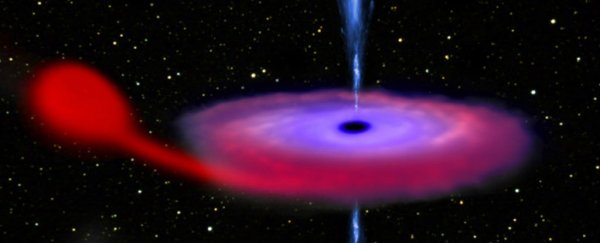As if black holes needed another horrifyingly weird characteristic, astronomers have observed one of the brightest black hole 'outbursts' in years, with each pulse emitting the energy of 1,000 Suns.
The event was witnessed back in June 2015 when V404 Cygni, a black hole that lies roughly 7,800 light-years from Earth, dramatically brightened for a two-week period as it devoured material from a neighbouring star, the team from the University of Southampton in the UK reports.
The bright red pulses of energy were the result of material getting ejected from the black hole as it ate up other material. As V404 Cygni gobbled up star materials, some of it was expelled through a jet at its base. Exactly how these jets form is still a mystery.
Though the bursts were incredibly short, they were extremely powerful. According to the team, "each flash was blindingly intense, equivalent to the power output of about 1,000 Suns, and some of the flashes were shorter than 1/40th of a second - about 10 times faster than the duration of a typical blink of an eye".
This news comes shortly after LIGO researchers were able to calculate that black holes can release up to 36 septillion yottawatts (a number that's so ridiculous it sounds made up) when they merge together - an event that results in ripples in spacetime instead of bursts of red light.
Since these events happen so far away, studying black hole bursts is quite the challenge. In the case of V404 Cygni, the researchers used the ULTRACAM fast-imaging camera, which was mounted to the William Herschel Telescope on the Canary Islands.
The ULTRACAM allowed the team to capture the bursts in colour. However, nothing would have been possible if astronomers from around the world weren't sharing information about when they suspected these bursts to happen.
Basically, if no one knows that a certain black hole has a history of outbursts, we have no idea where to look for them. For V404 Cygni, its last outburst came in 1989, which is why researchers were already looking at it to capture the new bursts on film.
"The 2015 event has greatly motivated astronomers to coordinate worldwide efforts to observe future outbursts. Their short durations, and strong emissions across the entire electromagnetic spectrum, require close communication, sharing of data, and collaborative efforts amongst astronomers," said one of the team, Poshak Gandhi.
While the bursts are awesome on many levels, researchers are especially excited, because these types of observations could help them understand how jets form and what different coloured bursts signify. To answer these questions, more research is required - a task that is exceptionally challenging, because most bursts are very dim and occur without warning.
The team's full report is available in Monthly Notices of the Royal Astronomical Society.
